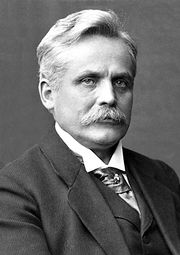Wilhelm Wien
| Wilhelm Wien | |
|---|---|
 |
|
| Born | Wilhelm Carl Werner Otto Fritz Franz Wien 13 January 1864 Fischhausen, East Prussia |
| Died | 30 August 1928 (aged 64) Munich, Germany |
| Nationality | German |
| Fields | Physics |
| Institutions | University of Giessen University of Würzburg University of Munich RWTH Aachen |
| Alma mater | University of Göttingen University of Berlin |
| Doctoral advisor | Hermann von Helmholtz |
| Doctoral students | Karl Hartmann Gabriel Holtsmark |
| Known for | Blackbody radiation Wien's law |
| Notable awards | Nobel Prize for Physics (1911) |
Wilhelm Carl Werner Otto Fritz Franz Wien (German pronunciation: [ˈviːn]; 13 January 1864 – 30 August 1928) was a German physicist who, in 1893, used theories about heat and electromagnetism to deduce Wien's displacement law, which calculates the emission of a blackbody at any temperature from the emission at any one reference temperature.
He also formulated an expression for the black-body radiation which is correct in the photon-gas limit. His arguments were based on the notion of adiabatic invariance, and were instrumental for the formulation of quantum mechanics. Wien received the 1911 Nobel Prize for his work on heat radiation.
Contents |
Biography
Early years
Wien was born at Gaffken near Fischhausen (Rybaki), Province of Prussia (now Primorsk, Russia) as the son of landowner Carl Wien. In 1866, his family moved to Drachstein, in Rastenburg (Rastembork).
In 1879, Wien went to school in Rastenburg and from 1880-1882 he attended the city school of Heidelberg. In 1882 he attended the University of Göttingen and the University of Berlin. From 1883-85, he worked in the laboratory of Hermann von Helmholtz and, in 1886, he received his Ph.D. with a thesis on the diffraction of light upon metals and on the influence of various materials upon the color of refracted light. From 1896 to 1899, Wien lectured at the prestigious RWTH Aachen University. In 1900 he went to the University of Würzburg and became successor of Wilhelm Conrad Röntgen.
Career
In 1896 Wien empirically determined a distribution law of blackbody radiation, later named after him: Wien's law. Max Planck, who was a colleague of Wien's, did not believe in empirical laws, so using electromagnetism and thermodynamics, he proposed a theoretical basis for Wien's law, which became the Wien-Planck law. However, Wien's law was only valid at high frequencies, and underestimated the radiancy at low frequencies. Planck corrected the theory and proposed what is now called Planck's law, which led to the development of quantum theory. However, Wien's other empirical forumlation  , called Wien's displacement law, is still very useful, as it relates the peak wavelength emitted by a body (λmax), to the temperature of the body (T). In 1900 (following the work of George Frederick Charles Searle), he assumed that the entire mass of matter is of electromagnetic origin and proposed the formula
, called Wien's displacement law, is still very useful, as it relates the peak wavelength emitted by a body (λmax), to the temperature of the body (T). In 1900 (following the work of George Frederick Charles Searle), he assumed that the entire mass of matter is of electromagnetic origin and proposed the formula  for the relation between electromagnetic mass and electromagnetic energy.
for the relation between electromagnetic mass and electromagnetic energy.
While studying streams of ionized gas, Wien, in 1898, identified a positive particle equal in mass to the hydrogen atom. Wien, with this work, laid the foundation of mass spectroscopy. J. J. Thomson refined Wien's apparatus and conducted further experiments in 1913 then, after work by Ernest Rutherford in 1919, Wien's particle was accepted and named the proton.
See also
- Wien's distribution law
- History of special relativity
- Mass–energy equivalence
Publications
- Wien, Wilhelm (1898). "Wikisource: Ueber die Fragen, welche die translatorische Bewegung des Lichtäthers betreffen". Annalen der Physik 301 (3): I–XVIII.
- Lehrbuch der Hydrodynamik (1900)
- Wien, Wilhelm (1900). "Wikisource: Über die Möglichkeit einer elektromagnetischen Begründung der Mechanik". Annalen der Physik 310 (7): 501–513. doi:10.1002/andp.19013100703.
- Wien, Wilhelm (1904a). "Wikisource: Über die Differentialgleichungen der Elektrodynamik für bewegte Körper. I". Annalen der Physik 318 (4): 641–662. doi:10.1002/andp.18943180402.
- Wien, Wilhelm (1904b). "Wikisource: Über die Differentialgleichungen der Elektrodynamik für bewegte Körper. II". Annalen der Physik 318 (4): 663–668. doi:10.1002/andp.18943180403.
- Wien, Wilhelm (1904c). "Wikisource: Erwiderung auf die Kritik des Hrn. M. Abraham". Annalen der Physik 319 (8): 635–637. doi:10.1002/andp.19043190817.
- Wien, Wilhelm (1904d). "Wikisource: Zur Elektronentheorie". Physikalische Zeitschrift 5 (14): 393–395.
- Aus dem Leben und Wirken eines Physikers (1930, memoir)
References
- E. Rüchardt (1955). "Zur Erinnerung an Wilhelm Wien bei der 25. Wiederkehr seines Todestages". Naturwissenschaften 42 (3): 57–62. doi:10.1007/BF00589524.
- E. Rüchardt (1936). "Zur Entdeckung der Kanalstrahlen vor fünfzig Jahren". Naturwissenschaften 24 (30): 57–62. doi:10.1007/BF01473963.
External links
- Wilhelm Wien
- O'Connor, John J.; Robertson, Edmund F., "Wilhelm Wien", MacTutor History of Mathematics archive, University of St Andrews, http://www-history.mcs.st-andrews.ac.uk/Biographies/Wien.html.
|
||||||||||||||||||||
|
||||||||